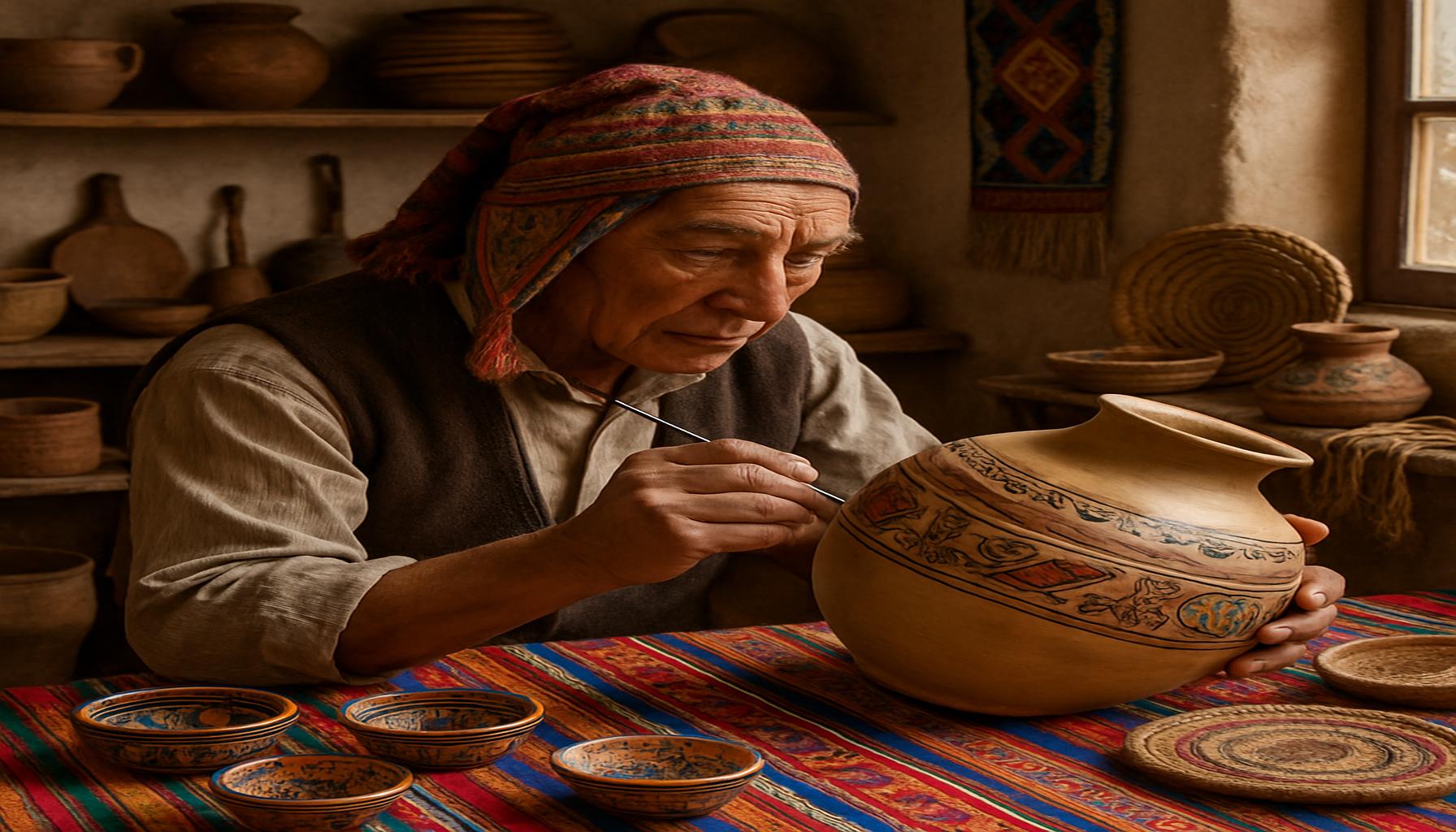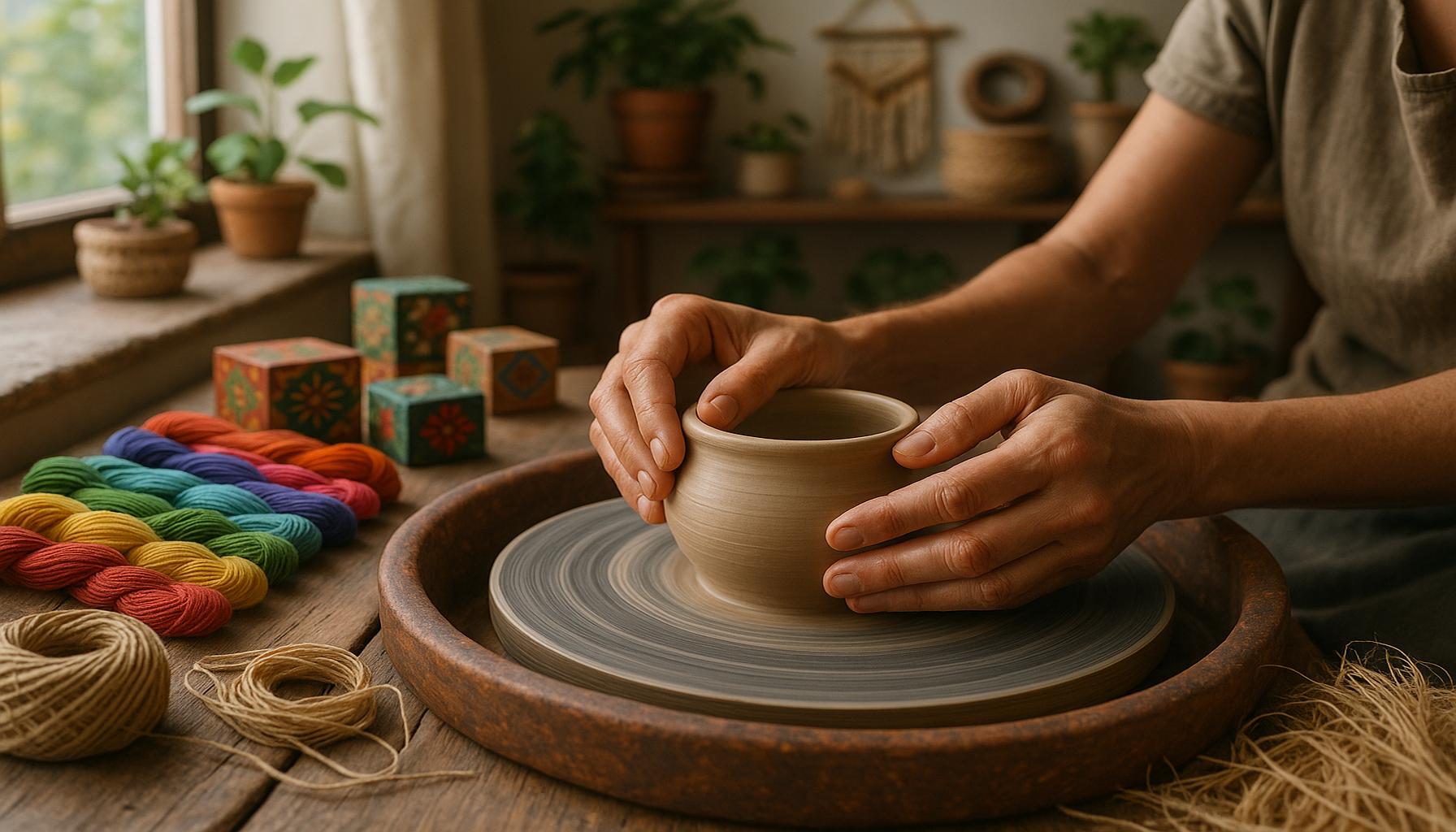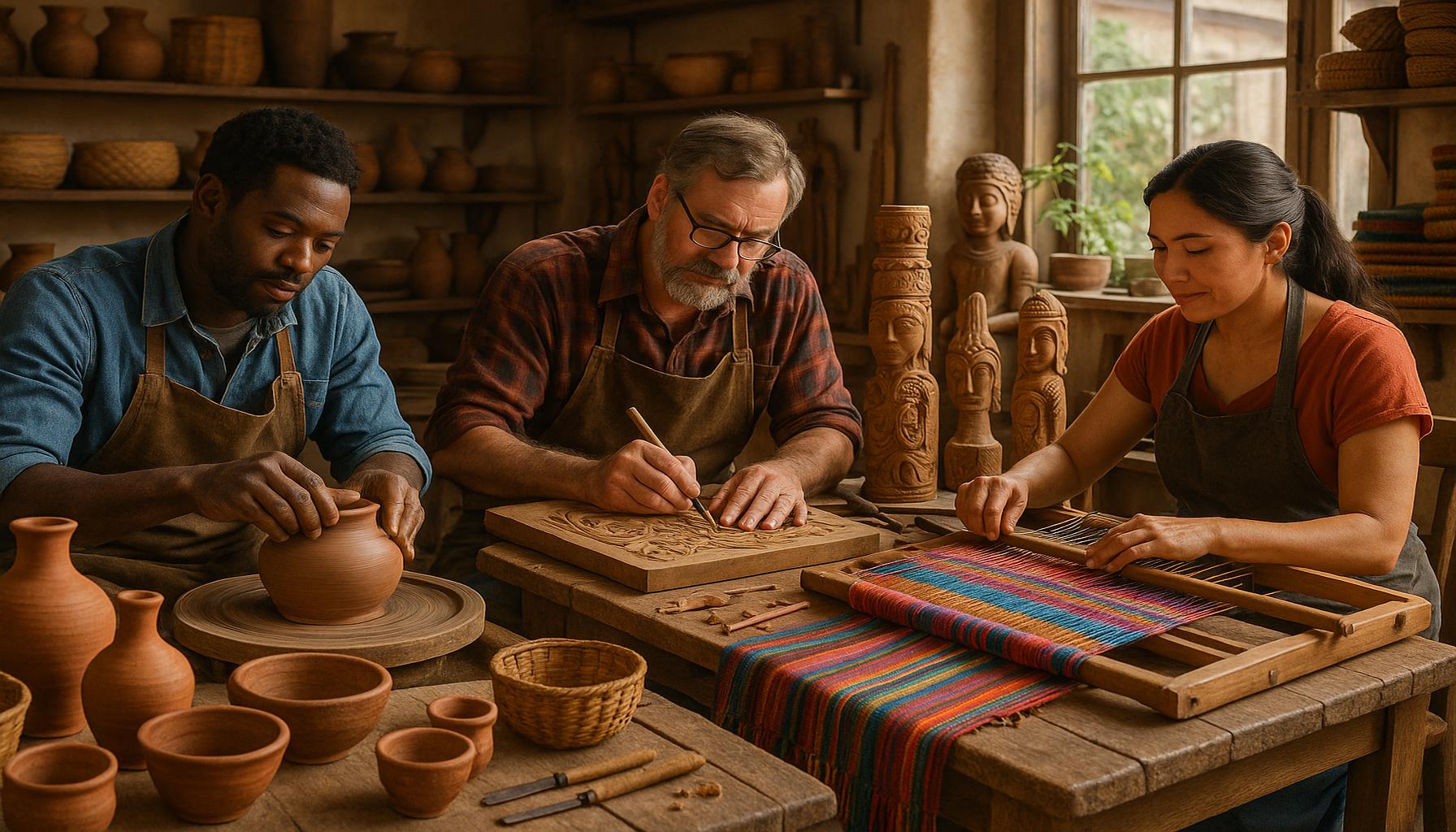Craftsmanship and Local Culture: Exploring Regional Traditions Through the Creation of Unique Pieces

Exploring the Heart of Regional Traditions
Across the United States, craftsmanship serves as a living testament to diverse local cultures. Each unique piece created reflects a story—woven from history, community, and heritage. The intricate dance between artisan skills and regional influences not only produces beautiful artifacts but also encapsulates the essence of the areas in which these crafts are founded.
One of the most compelling components of regional craftsmanship is the use of distinctive materials. For instance, artisans in the Pacific Northwest often utilize locally sourced cedar, a tree that grows abundantly in the area. This wood is renowned for its aromatic scent and natural resistance to decay, making it an ideal material for constructing totem poles that tell stories of ancestral heritage. Similarly, pottery crafted in New Mexico often incorporates local clay mixed with natural minerals, allowing artisans to create vibrant and durable pieces that echo the rich geological history of the region.
In addition to materials, the traditional techniques passed down through generations play a pivotal role in preserving cultural identity. Many Native American tribes, for example, utilize weaving techniques handed down for centuries. The intricate patterns found in Navajo rugs and blankets not only serve as functional items but also as canvases showcasing stories, symbols, and spiritual significance deeply rooted in their culture. These techniques are often taught in community settings, ensuring that younger generations remain connected to their heritage.
Moreover, the craft landscape is not just a repository of the past; it is also a vibrant space for innovative designs. Modern artisans are increasingly merging contemporary aesthetics with traditional methods. This fusion can be seen in the work of furniture makers in Pennsylvania, who combine the classic Shaker style with modern lines and finishes, creating pieces that appeal to today’s consumers while honoring age-old craftsmanship.
From intricate pottery in New Mexico to handcrafted wooden furniture in Pennsylvania, the craft landscape is rich and varied. Each piece not only serves a functional purpose but also captures the essence of its origin. As you delve deeper into the world of craftsmanship, consider how these creations enhance our understanding of regional traditions. Each artisan contributes to a narrative that fosters pride, sustains communities, and invites exploration.
Why Craftsmanship Matters
Beyond aesthetics, craftsmanship plays a critical role in supporting local economies. Small businesses and artisan markets thrive on the unique appeal of handcrafted items, providing consumers with products that are not mass-produced and often come with a story. This connection to local artisans fosters community spirit and encourages a cycle of support within the local economy.
Additionally, craftsmanship can spark cultural exchanges that enrich communities. When artisans showcase their work at regional fairs or galleries, they not only sell their products but also share their cultural narratives, creating opportunities for dialogue and understanding. This exchange helps to break down barriers, allowing individuals from different backgrounds to engage with and appreciate each other’s heritage.
Lastly, there is a rising movement focused on reviving forgotten techniques that deserve to be celebrated. As more people seek sustainable and authentic products, the revival of skills such as blacksmithing or traditional dyeing methods has gained traction. Workshops and classes are popping up across the country, teaching these nearly lost crafts to new generations.
Embark on this journey with us to discover how craftsmanship captures the spirit of local culture and transforms it into something remarkable. As we appreciate these artisans and their work, we gain a deeper understanding of the rich tapestry that makes up the American cultural landscape.
DIVE DEEPER: Click here to discover more about music as a creative outlet
The Role of Craftsmanship in Celebrating Local Heritage
Craftsmanship is much more than a means to create functional objects; it is an expression of local culture and a medium through which the stories of a region can be conveyed. In every unique piece crafted, emotions, traditions, and the spirit of the community are embedded. This makes each artifact not only a product but a narrative intertwined with the historical and social context of its origins.
Across different regions in the United States, artisans use their skills to capture the essence of their environments. The South, known for its rich traditions of quilting, showcases the importance of community gatherings in the creative process. Quilting bees bring together individuals who share techniques, patterns, and stories while simultaneously sewing together patches that represent family histories. Each quilt becomes a vibrant tapestry, connecting generations and reflecting the artistic expression of the broader Southern culture.
In contrast, the Rocky Mountain region highlights the significance of natural elements in craftsmanship. Artisans here often incorporate materials such as stone and metal to create functional pieces that mirror the rugged landscape. This symbiotic relationship between the crafts and the environment reveals how local resources can influence design. For instance, blacksmiths in Colorado might use iron mined from nearby hills to produce custom gates and home decor, each piece laden with meaning derived from the landscape itself.
- Artistic Patterns: Local crafts often feature distinctive patterns that represent cultural symbols or historical narratives.
- Use of Indigenous Materials: Crafts in different regions utilize materials that are sourced exclusively from local environments, emphasizing sustainability.
- Traditional Celebrations: Many regions honor craftsmanship by integrating it into local festivals and fairs, thereby promoting cultural pride.
The connection between craftsmanship and the local labor force is also significant. Artisans often employ traditional methods tailored to their regional context, which adds to the authenticity and uniqueness of each piece. The art of glassblowing, as practiced in places like Corning, New York, exemplifies how specific locations can spawn specialized craft techniques. Here, artisans have perfected the intricate art of transforming molten glass into both functional items and artistic sculptures, pushing the boundaries of what can be achieved in this medium while drawing from a rich historical legacy.
Understanding the dynamics of craftsmanship involves exploring not only the techniques but also the cultural narratives that these artisans perpetuate. As more consumers become aware of the value of handcrafted items, a resurgence of interest in traditional crafts is occurring. This has prompted a revival of local craft fairs, workshops, and festivals where artisans can share their expertise with a wider audience. By supporting these local endeavors, artisans not only sustain their livelihoods but also play an essential role in preserving the cultural fabrics of their communities.
As we continue to uncover the role of craftsmanship in celebrating local heritage, it becomes clear that these uniquely crafted pieces serve as a bridge connecting past and present. In every carved wooden sculpture or hand-woven basket, we find not just artistic expression, but a vibrant connection to the community’s rich tapestry of traditions and values.
Craftsmanship and Local Culture: Celebrating Unique Traditions
Across the globe, the art of craftsmanship is an embodiment of local culture, ensuring that rich traditions are not lost with time. Each handcrafted piece tells a story, reflecting the unique heritage of the region it comes from. For instance, in regions known for their pottery, artisans often utilize techniques passed down through generations, instilling a sense of pride and cultural identity in their work. This pursuit of creating unique pieces transcends mere aesthetics, engaging communities in a shared narrative of their ancestry and values.
Moreover, the resurgence of interest in sustainability revitalizes local craftsmanship. Consumers increasingly seek products with a story, where the materials and methods used honor traditional practices. The connection to the community that these artisans foster generates not only economic opportunities but also a greater appreciation for handmade goods over mass production. This trend encourages a deeper connection between the buyer and the maker, enriching both experiences.
| Category | Advantage |
|---|---|
| Cultural Heritage | Preserves and reflects local traditions and history. |
| Economic Support | Boosts local economies by creating jobs within communities. |
By exploring craftsmanship through the lens of local culture, we can uncover the vital relationships between artistry, identity, and economy. This nexus highlights the value of not just acquiring unique pieces, but also the stories and cultural significance that accompany them, making each acquisition a step towards preserving heritage.
DISCOVER MORE: Click here to delve deeper
The Intersection of Craftsmanship and Community Engagement
As regional artisans cultivate their distinctive crafts, an integral component of their artistic practice is the active engagement with the community. This relationship not only enriches the artistic process but also fosters a sense of collective identity. In many areas, local artisans collaborate with community members through programs and workshops that empower individuals to explore their own creativity. Such interactions nurture a sense of belonging and provide participants with the tools to express their personal narratives through craftsmanship.
A striking example of this community engagement can be seen in the vibrant art scene of New Mexico, where Pueblo pottery has lived through generations. Artisans such as those from the Acoma Pueblo exemplify the blending of traditional techniques with communal storytelling. Workshops invite both locals and tourists to learn the revered techniques of hand-coiling and mural painting, effectively embedding the art of pottery into the lives of those who participate. The resulting pieces are not only artistic expressions but also embrace stories of shared heritage, family, and resilience.
The role of craftsmanship as a catalyst for social change is also profound. For example, in urban landscapes like Detroit, an ailing manufacturing city, grassroots initiatives focused on craft have emerged as symbols of regeneration. Through creative spaces and collaborative workshops, community members are able to reclaim their local identity. The design of furniture that is made from reclaimed materials not only highlights sustainability but also brings awareness to the city’s industrial history. Such efforts illustrate how craftsmanship can transform socio-economic challenges into opportunities for cultural revitalization.
- Collaborative Projects: Local artisans are increasingly engaging in collaborative projects that merge diverse cultural practices, fostering inclusivity and innovation.
- Skill Transfer: Many craftspeople prioritize the transfer of knowledge to younger generations, ensuring that traditional skills are preserved and adapted for future contexts.
- Community Spaces: Artisans often create community spaces where individuals can gather, share ideas, and foster artistic growth, making craftsmanship a communal activity.
Moreover, many regions across the country are seeing craft fairs and artisanal markets becoming popular platforms for the exchange of unique pieces. These events not only showcase the talents of local artisans but also serve as a cultural melting pot where diverse traditions can coexist and inspire each other. In places like Asheville, North Carolina, local festivals celebrate traditional Appalachian crafts, offering workshops in everything from basket weaving to dulcimer making. Here, both artisans and visitors engage in immersive experiences that elevate appreciation for handcrafted items while also reinforcing the significance of preserving local traditions.
The integration of craftsmanship into public art initiatives further amplifies the impact of artisans. Cities such as Chicago have embraced initiatives that involve local craftsmen in the creation of murals and installations that reflect the city’s rich cultural diversity. These works serve not just as aesthetic enhancements but as participatory projects that spark conversations about the community’s history and identity. Through this lens, craftsmanship transcends mere object-making; it becomes a dynamic tool for fostering dialogue and community cohesion.
As the landscape of American craftsmanship continues to evolve, the interplay between individual artistry and collective memory remains pivotal. Local crafts become not only a source of economic sustenance but also a vital component in the ongoing narrative of community identity, making the appreciation of these unique pieces essential for understanding and celebrating regional traditions.
DISCOVER MORE: Click here for insights on creative writing
Conclusion: The Enduring Legacy of Craftsmanship
In exploring the rich tapestry of craftsmanship and local culture, it becomes evident that these unique pieces are far more than mere objects; they are profound embodiments of community identity, heritage, and collective storytelling. As artisans continue to blend traditional methods with modern innovation, they not only keep their regional customs alive but also infuse them with new meaning and relevance for contemporary society.
The connections formed through crafting—whether in collaborative workshops, community festivals, or local art initiatives—serve to strengthen the bonds within communities. They engage participants in ongoing dialogues around sustainability, cultural heritage, and social change. Furthermore, venues such as craft fairs and artisanal markets have opened doors for interaction between artisans and audiences, allowing for an exchange of ideas and shared experiences that enrich cultural narratives.
As we continue to witness the revival and celebration of regional traditions across the United States, it becomes all the more important to appreciate the craftsmanship that goes into each unique piece. This appreciation not only honors the skills of artisans and the histories they represent, but it also challenges us to recognize our role in preserving this cultural legacy for future generations. By embracing local crafts, we actively participate in a movement that champions creativity, inclusivity, and the resilience of community. The importance of craftsmanship in shaping our understanding of local culture cannot be overstated; it is a living, breathing art form that reflects who we are and where we come from.


